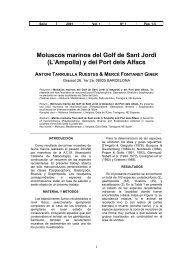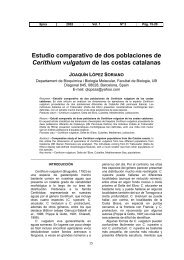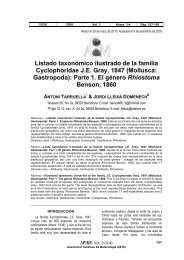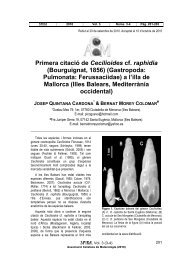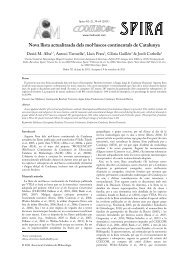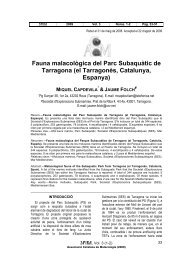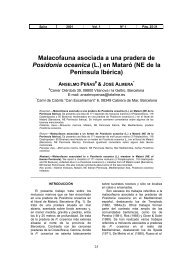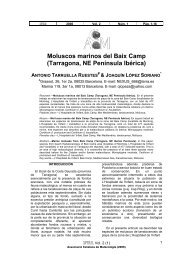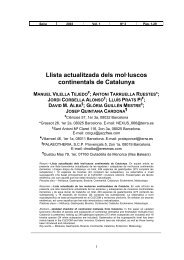Dues noves espècies del gènere Moitessieria ... - MOLLUSC@T
Dues noves espècies del gènere Moitessieria ... - MOLLUSC@T
Dues noves espècies del gènere Moitessieria ... - MOLLUSC@T
Create successful ePaper yourself
Turn your PDF publications into a flip-book with our unique Google optimized e-Paper software.
COUTAGNE, G. (1884). Révision sommaire<br />
du genre <strong>Moitessieria</strong>. Feuille Jeunes<br />
Natural., 14(165): 105-110.<br />
FALKNER, G.; RIPKEN, T.E.J.; FALKNER, M.<br />
(2002). Mollusques continentaux de<br />
France. Liste de Référence annotée et<br />
Bibliographie. Publications scientifiques<br />
de M.N.H.N., Paris.<br />
GHAMIZI, M.; BODON, M.; BOULAL, M.;<br />
GIUSTI, F. (1999). Attebania<br />
bernasconii, a new genus and species<br />
from subterranean waters of the Tiznit<br />
Plain, Southern Morocco (Gastropoda:<br />
Hydrobiidae). J. Moll. Stud., 65: 89-98.<br />
GIRARDI, H. (2003). <strong>Moitessieria</strong> calloti<br />
espèce nouvelle: redescriptions de<br />
<strong>Moitessieria</strong> rhodani (Bourguignat,<br />
1893) et autres Moitessieres du Gard et<br />
de l’Ardèche, France (Gastropoda:<br />
Moitessieriidae). Doc. Malacol., 4: 59-<br />
65.<br />
HAAS, F. (1924). Contribució a la<br />
malacofauna de la conca inferior de<br />
l’Ebre. Butll. Inst. Catal. Hist. Nat., 24<br />
(2ª sèr. 4): 48-63.<br />
MANGANELLI, G.; BODON, M.; CIANFANELLI,<br />
S.; TALENTI, E.; GIUSTI, F. (1998). New<br />
hydrobiids from subterranean waters of<br />
eastern Sardinia, Italy (Gastropoda<br />
Prosobranchia: Hydrobiidae). Basteria,<br />
62: 43-67.<br />
ROLÁN, E. & MARTÍNEZ-ORTÍ, A. (2003).<br />
Nuevas especies de la familia<br />
Hydrobiidae (Mollusca,<br />
Orthogastropoda) de la Comunidad<br />
Valenciana (España). Iberus, 21: 191-<br />
206.<br />
VILELLA TEJEDO, M.; TARRUELLA RUESTES,<br />
A.; CORBELLA ALONSO, J.; PRATS PI, L.;<br />
ALBA, D.M.; GUILLÉN MESTRE, G.;<br />
QUINTANA CARDONA, J. (2003). Llista<br />
actualitzada <strong>del</strong>s mol·luscos<br />
continentals de Catalunya. Spira, 1(3):<br />
1-29.<br />
WILKE, T.; DAVIS, G.M.; FALNIOWSKI, A.;<br />
GIUSTI, F.; BODON, M.; SZAROWSKA, M.<br />
(2001). Molecular systematics of<br />
Hydrobiidae (Mollusca: Gastropoda:<br />
Rissooidea): testing monophyly and<br />
phylogenetic relationshisps. Proc.<br />
Acad. Nat. Sc. Phil., 151: 1-21.<br />
110<br />
SPIRA, Vol. 2 (2)<br />
Associació Catalana de Malacologia (2006)<br />
APÈNDIX<br />
Diagnoses of the new species<br />
(English translation)<br />
<strong>Moitessieria</strong> mugae sp. nov.—<br />
Average-sized species of <strong>Moitessieria</strong>,<br />
comparable to M. simoniana (average<br />
length 1.9 mm, average width 0.6 mm);<br />
turriculate and elongated shell, usually with<br />
6-6½ whorls, subcylindrical and slender<br />
(average length/width index of 3.1);<br />
planoconvex whorls, with superficial and<br />
slightly-inclined sutures (18º on average);<br />
external aperture lip slightly prominent, with<br />
the last whorl not being very inflated;<br />
slightly marked sinule; upper edge of the<br />
peristome very adhered to the parietal<br />
zone; peristome not expanded at all and<br />
slightly reflected at columellar level; closed<br />
(obliterated) umbilicus; ornamentation of<br />
the teleoconch formed by a slightly-marked<br />
reticule of quadrangular depressions, with a<br />
low striation density; protoconch without<br />
noticeable ornamentation.<br />
<strong>Moitessieria</strong> collellensis sp. nov.—<br />
Large-sized species of <strong>Moitessieria</strong><br />
(average length 2.2 mm, average width 0.9<br />
mm); turriculate and elongated shell,<br />
usually with 6¾-7¼ whorls,<br />
conicocylindrical and moderately to very<br />
robust (average length/width index of 2.4);<br />
convex whorls, with deep and very-slightlyinclined<br />
sutures (13º on average); external<br />
aperture lip prominent, with the last whorl<br />
not being very inflated; very marked sinule;<br />
upper edge of the peristome slightly<br />
separated or slightly adhered to the parietal<br />
zone; peristome very expanded and<br />
generally very reflected at columellar level;<br />
open and usually very wide umbilicus;<br />
ornamentation of the teleoconch formed by<br />
a well-marked reticule of quadrangular<br />
depressions, more marked in spiral<br />
direction, with a low striation density;<br />
ornamentation of the protoconch consisting<br />
on spirally arranged papillae and<br />
discontinuos crests.



